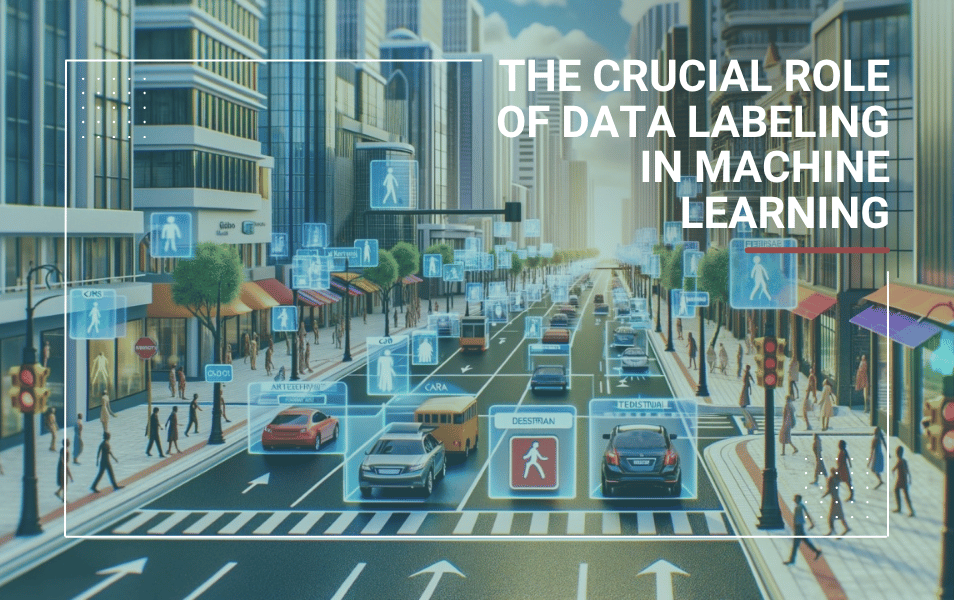Introduction
Within the sphere of Data, Information, Value, and Impact (DIVI), this blog series now delves into the sophisticated process of Data labeling. We are now at the stage where we have captured a vast amount of images or data from other sensors. A point cloud from an imaging radar or a LiDAR module. A time-series from an ultrasonic sensor. And now we want to make “chocolate” out of this, which is how my former room colleague always called it. We want to distill the information out of the data, which in the end should be of Value to the application.
Now we can of course make use of classic computer vision algorithms. However, in the last years, we have seen the rise of deep learning applications. Compared to classic computer vision algorithms, here we train an AI model with a vast amount of training data. We essentially need to tell the AI model how a car looks like, what a pole is within a point cloud, and differentiate static from dynamic objects. Labels or annotations are being used as input for the AI training process.
Data labeling aka annotating
Data labeling is the linchpin in the domain of supervised machine learning. Through this laborious process, unstructured data is meticulously classified. Classification is essentially the process of telling the AI model the difference between a tree and a human (in very simple words). The labeling process even can be used to develop predictive AI models that can extrapolate learned patterns to new, unlabeled data, ensuring the continuous evolution of autonomous systems.
For autonomous systems, the labeling process involves discerning relevant features within a multimodal dataset. This includes not only the obvious visual markers but also more abstract patterns within sensor readings and time-series data. The challenge lies in developing labeling protocols that can effectively translate such high-dimensional data into a form that is both comprehensible and useful for machine learning purposes.
Manual vs. automatic labeling
You have the choice to either use manual labeling, automatic labeling, or a hybrid model. Today, manual labeling involves the effective use of a crowd of human (low-cost) annotators. In contrasting manual with automatic labeling, one must consider the trade-offs between the granular accuracy of human annotators and the expediency of algorithmic labeling. Manual annotation ensures nuanced understanding, capturing subtleties that automated systems might overlook.
Conversely, automated labeling algorithms can process vast datasets at a pace unattainable by human annotators, although they may require additional validation to achieve comparable levels of precision. Therefore, many labeling providers out there choose to a more hybrid, blended approach.
Labeling resolution
The granularity of annotation—whether opting for rudimentary bounding boxes or finely-detailed polygonal outlines—has profound implications for the resulting dataset. High-resolution annotations enable more sophisticated pattern recognition by machine learning models, facilitating nuanced interactions with the environment, which is essential for the fine-tuned operations of autonomous vehicles.
Data privacy and GDPR
Navigating the complexities of GDPR compliance in data labeling demands innovative solutions that reconcile the imperatives of data utility and privacy. This involves the application of advanced anonymization techniques, such as differential privacy, to ensure that the process of labeling sensitive datasets adheres to stringent regulatory standards. You don’t want to have license plates or human faces to go undetected by the AI model. Some labeling companies out there choose a technique called generative AI to replace faces and license plates in the unlabeled data with non-existing faces and license plates.
Challenges and strategies for high-quality data annotation
The endeavor to annotate data for autonomous vehicles encompasses a multitude of challenges, including but not limited to the heterogeneity of data sources, the interoperability of annotation software, and the representativeness of labeled datasets. These challenges necessitate a robust annotation pipeline capable of handling diverse data formats and types, all while ensuring the annotations accurately reflect the variegated scenarios an autonomous vehicle may encounter.
To achieve high fidelity in data annotation, several hybrid strategies are paramount:
- Developing clear and comprehensive annotation guidelines based on consensus from domain experts.
- Establishing a robust review and validation cycle that integrates both human expertise and automated checks to ensure annotation integrity.
- Implementing a consensus pipeline that utilizes machine learning techniques to reconcile discrepancies among annotators.
- Fostering an environment of continuous improvement through active feedback mechanisms and adaptive learning for annotators.
Data labeling today and tomorrow
The data annotation sector is experiencing robust growth, with market analysis indicating a substantial compound annual growth rate. This expansion is fueled by the escalating integration of deep learning models across various industry verticals, necessitating large volumes of high-quality annotated data. The shift towards outsourcing is indicative of the market’s inclination towards specialization and the quest for scalable and cost-efficient annotation solutions.
Looking to the horizon, the demand for data annotation is projected to increase in tandem with the evolution of AI technologies. Significant advancements in annotation methodologies are foreseen, bolstered by a stronger emphasis on quality assurance mechanisms. Furthermore, a consolidation within the market is anticipated, with ethical considerations taking a more central role in annotation practices.
Conclusion
Data labeling stands as a critical and complex facet in the broader narrative of AI development. As we continue to push the boundaries of what is technologically feasible, a concerted effort to refine the data labeling process is imperative. I invite you to engage with this dialogue, by following me and leaving your comments below.
See you soon in the next article, where I will be moving closer to the definition of Value!
